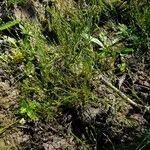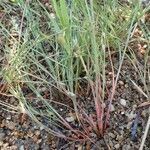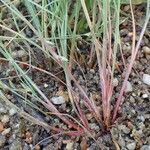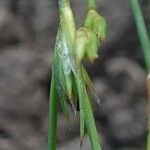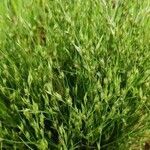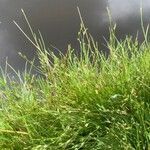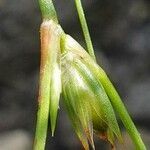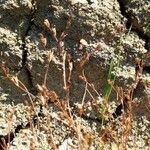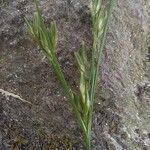Very variable, pale-coloured annual, usually 10-30 cm long, rarely longer. Stems tufted, all fertile, erect, erecto-patent or decumbent, slender, terete, soft, often branched, leafy. Leaf-sheaths rather long, not auricled. Leaves linear, very narrow, channelled down the face, the lowmost up to 16 cm long, the higher shorter. Inflorescence terminal, branched; branches erect or obliquely erect, rather straight. Flowers either solitary and remote or in more or less remote (sometimes almost crowded) clusters of 2-6; each flower at the base with a bract and 2 bracteoles; flowers nearly sessile, pale-coloured, very variable as to size, 3-7 mm long. Bracts and bracteoles thinly membranous, ovate, acute. Tepals narrowly ovate-lanceolate, very acute, the 3 inner often much smaller than the outer. Stamens 6, in the topmost flowers often 3. Style distinct; stigmas straight. Capsule oblong, trigonous, usually shorter than the perianth, 3-5 mm long; placentas at length often detached from the valves, either free or cohering into a central column. Seeds numerous, ellipsoid, tailless, brown, extremely faintly ribbed, ⅓-½ mm long.
Plants annual, 4--20(--30) cm tall. Stems usually many, erect or ascending, usually weak, base often reddish brown. Leaves basal and cauline; leaf sheath often swollen basally, margin hyaline; leaf blade flat, 1--13 cm × ca. 1 mm, margin often slightly convolute. Inflorescences usually lax, 1/4--4/5 × plant height; branches few, ascending, somewhat arcuate, usually weak, few flowered. Flowers subterminal, remote, appressed to subappressed; involucral bract leaflike. Bracteoles 2 or 3, 1.3--2.5 × 1.2--2.2 mm. Perianth segments lanceolate; outer segments 4.25--5.5 × 1--1.8 mm, center green, margin broadly white membranous, apex sharply pointed; inner segments 4--5 mm, often mostly membranous, apex acute. Stamens 6, 1/3--1/2 as long as perianth; filaments 0.8--1.2 mm; anthers 0.5--0.8 mm. Style absent; stigmas ca. 0.5 mm. Capsule ovoid to subellipsoid, 3--4(--5) mm, 3-loculed, apex slightly obtuse. Seeds ellipsoid, 0.4--0.6 mm, striate, base and apex usually apiculate. Fl. May--Jul, fr. Jun--Sep. 2 n = 100, 110.
Herbs, annual, cespitose, 0.5--4 dm. Culms 1--many, occasionally becoming decumbent. Cataphylls 0--2. Leaves basal and cauline; auricles rudimentary or absent; blade flat, 3--13 cm x 0.3--1.1 mm. Inflorescences loose and diffuse or less often compact, usually at least ½1/2 total height of plant; primary bract shorter than inflorescence. Flowers: bracteoles 2; tepals greenish, lanceolate, 3.8--7(--8.5) mm; inner series slightly shorter, apex sometimes obtuse; stamens 3--6, filaments (0.7--)1--1.8 mm, anthers 0.3--0.8 mm; style 0.1--0.2 mm. Capsules tan to reddish brown, 3-locular, ellipsoid to narrowly so, slightly truncate, 2.7--4 x 1--1.5 mm, sometimes exceeding inner tepals but usually not outer series. Seeds yellowish, widely ellipsoid to ovoid, 0.26--0.49, not tailed. 2n = 27--37, 58--81, 108--115.
Annual, rarely longer lived, tufted, light green or, in dry situations, often red-tinged, extremely variable, (2.5)-10-20-(40) cm high, whole plant easily pulled out of ground, roots fibrous. Stems simple or branched near base, branching above to form inflorescence. Leaves few, mostly basal, occasionally cauline, ± setaceous, ± channelled, auricles absent. Inflorescence highly variable in size and shape, often ⅔ length of whole plant. Flowers sessile, borne singly or in 2-7-flowered clusters. Tepals (3)-4-6-(9) mm long, outer tepals longer-acuminate than inner. Stamens (3)-6.Capsule (2.5)-3-4 mm long, < tepals, oblong, blunt, green to bright red-brown.
Annuals, tufted, soft, 30-300 mm tall. Leaves few, radical and cauline, narrowly linear-acuminate, with an orange, loosely sheathing base. Flowers in leafy panicles or lateral secund spikes, sessile, solitary; bracts 3, hyaline. Tepals c. 5 mm long, green with a hyaline border, outer aristate, inner shorter, acute. Stamens 6(-3), short; anthers about as long as filaments. Ovary 3-locular; style and stigmas about as long as perianth. Capsule included, ellipsoid, obtuse; seed obovoid, c. 0.4 mm long, base rounded, apex truncate, ribbed, pale brown, becoming mucilaginous when wet. Flowering in spring.
Annual herb, tufted, up to 300 mm high. Leaves few, radical and cauline, narrowly linear-acuminate. Flowers in much-branched, exserted panicles (anthelae), or lateral second spikes, sessile, solitary; bracts 3, hyaline. Perianth segments hard, green with a hyaline border, glumaceous. Stamens: anthers ± as long as filaments. Ovary with 3 ± separate locules; ovules biseriate, many; style terete with 3 stigmatic arms, ± as long as perianth. Capsule loculicidal, included, ellipsoid, obtuse. Seeds many, 0.4 mm long, apex truncate. Flowering time Jan.-Dec.
Soft annual, up to 300 mm high. Stems leafy. Leaves forming loose basal rosettes; blade flat, linear, base not persisting; cataphylls absent. Flowers: solitary or in clusters of 2-5, in leafy panicles, each flower with a bract and 2 bracteoles; perianth green; Oct.-Jan.
Soft annual, 15-30 cm. Leaves linear. Flowers in leafy, branched spikes, green.
